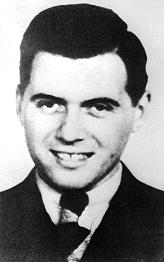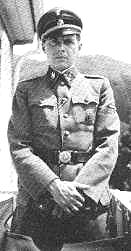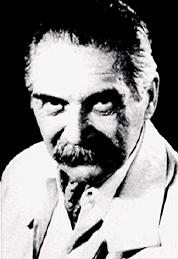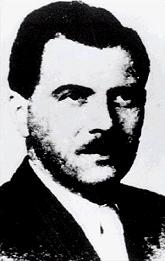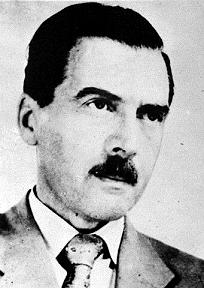|
|
|
|
|
|
| On March 16, 1911, in Gunzerburg, Germany, Josef Mengele was born into this world only to later become a murderer. No one would have known it though. “Beppo”, his childhood nickname, was thought of as bright and happy. He was also a good student. But the way people thought of him would change immensely later in life. | |
|
|
|
| Family | |
| Josef’s family consisted of five people: Karl and Walburga, his parents; his two younger brothers, Karl and Alois; and himself. Karl was a local industrialist who owned a plant that manufactured farming equipment. He was a stern, hard worker and wanted Josef to follow in his footsteps and work at the plant. Either that, or possibly become an accountant. Walburga was a terrible person, though. When she came to the plant, workers quickly spread the word that she was there and then hid from her. She may have even influenced Josef to commit his crime as a Schutzstaffel (SS) doctor. | |
|
|
|
| Education | |
| Even though Karl wanted Josef to work at his plant, Josef dreamed of a career in science and anthropology. When he took his Abitur, a college entrance test, he passed it with a very good score and was accepted at the University of Munich. One reason he accepted this offer so eagerly might have been because Munich was the heart of the National Socialist movement led by Hitler at the time. While there he majored in Philosophy and Medicine. In Philosophy, he studied the theory of “unworthy life,” which dictated that doctors had the right to destroy unworthy people with these sicknesses -- feeblemindedness, alcoholism, schizophrenia, Huntington’s disease, manic depression, physical deformities, epilepsy, deafness and hereditary blindness -- in order to further the perfection of the German race. His thesis was entitled “Racial Morphological Research on the Lower Jaw Section of Four Racial Groups.” | |
| In 1935 he earned his Ph.D. and in 1937, became research assistant at the Third Reich Institute for Hereditary, Biology and Racial Purity at the University of Frankfurt. There he worked with Professor von Verschuer. | |
| In May 1937 he joined the Nazis. He stayed with them until a year later when he received his medical degree from the University of Frankfurt. | |
| In October of that same year he began a three-month basic training course for the Wehrmacht. This training would prove important when the war started the following year. |
|
|
Josef as a Waffen SS officer in 1942 |
|
| In July 1939 Josef married Irene Schoenbein. Later, he joined the Waffen SS, first as a member of the medical corpse and then was appointed a second lieutenant. During this time he got involved with the genealogical section of the Race and Resettlement Office in occupied Poland. | |
| In June 1941 he was sent to Ukraine as part of the Waffen SS and received the Iron Cross, second class. While under enemy fire in the Viking Division, a tank exploded and Josef rescued two soldiers from it. Because of this he was awarded the Iron Cross, first class, the Black Badge for the Wounded and Medal for the Care of the German People. He was wounded in this act of courage and afterwards was transferred to the headquarters of the Race and Resettlement Office, Berlin, where he was appointed to captain. | |
| In May 1943 Josef went to Auschwitz to study genetic research on humans staying there. | |
|
|
|
| While at Auschwitz | |
| Before the war, Professor von Verschuer couldn‘t do experiments on humans, he could only observe his patients. When Josef arrived on May 30, 1943, in Auschwitz, von Verschuer assigned him to conduct “in vivo” experiments, which meant on live people. These were funded through a grant von Verschuer had obtained through the German Research Council. Josef’s goals were to find the secrets of genetic engineering and to discover a way to remove inferior gene strands from humans to create a German super-race. He really didn’t contribute to the understanding of genetics, but he gave cruelty a new name by doing his pseudo-medical experiments. | |
|
|
|
| Selections | |
| Josef was never absent at any of the Selections. Selections involved choosing people out of the new arrivals to be killed. At the Selections Josef always had a clean SS uniform with his medals on it. He used a riding crop to point left or right, which meant you were either going to the gas chambers or spared and put on Dr. Josef Mengele’s “list”. Only 10-30 percent of the new arrivals were spared. Before people went “on the walk to the chimney”, as Mengele called the trips to the gas chambers, they were stripped of everything they had for resale. | |
| Dr. Olga Lengyel recalls a typical day in Auschwitz and her hatred for Josef in this passage: | |
| “How we despised his detached, haughty air, his continual whistling, his frigid cruelty. Day after day he was at his post, watching the pitiful crowd of men and women and children go struggling past, all in the last stages of exhaustion from the inhumane journey in the cattle trucks. He would point with his cane ‘right’ or left’. He seemed to enjoy his grisly task.” | |
|
|
|
| Experiments | |
| People at Auschwitz referred to Mengele as the “Angel of Death,” and for good reason too. His subjects were sentenced to a worse fate than outright execution. Although they were able to keep their own hair, clothing and received extra food, this didn‘t make up for what they were put through. Guards had strict orders not to abuse them, even though hundreds of them died because of him. He had special barracks for twins, dwarfs, giants, cripples and other “exotic specimens”. These barracks were nicknamed “The Zoo”. | 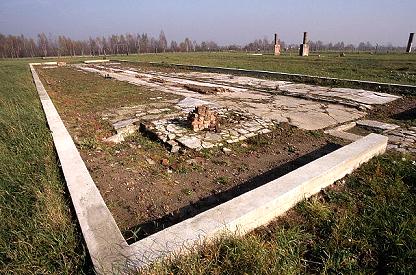 |
|
Ruins of the Infirmary at Auschwitz |
|
| Before any experimentation could be done, Mengele had his “children” fill out a questionnaire and examined them thoroughly, plus weighed and measured them. He also took daily blood samples from them, which he sent to von Verschuer in Berlin. The experiments he conducted were extremely painful and usually ended in death. Eye color was a main interest to him. He would inject dye into people’s eyes in order to genetically change their color, which usually resulted in extreme pain or even blindness. If the patients died, he would harvest their eyes and pin them on his wall just like someone pinning an insect on to Styrofoam. He also dissected live infants, castrated or sterilized men and boys and removed limbs and organs from people, all without anesthetics. One time he even killed a group of Polish nuns with an X-ray machine, burning them to death. Obviously he had no regard for life. Putting high-voltage electric shocks through women to test their endurance and injecting his subjects with infections to see how long it would take them to get a disease and die didn’t bother him either. | |
| Gisella Pearl, an inmate doctor, remembers when Mengele caught a girl trying to escape for the sixth time from the crowd going to the gas chambers: | |
| “He grabbed her by the neck and proceeded to beat her head to a bloody pulp. He hit her, slapped her, boxed her, always her head, while screaming at the top of his voice, ‘You want to escape, don’t you. You can’t escape now. You are going to burn like the others, you are going to croak, you dirty Jew.’ As I watched, I saw her two beautiful, intelligent eyes disappear under a layer of blood. And in a few seconds, her straight, pointed nose was a flat, broken bleeding mass. Half an hour later, Dr. Mengele returned to he hospital. He took a piece of perfumed soap out of his bag and whistling gaily with a smile of deep satisfaction on his face, he began to wash his hands.” | |
| Even though he killed Jews, he was thought to have a sexual longing for the Jewish women, as many did for him because of his looks and confident manner. They were forbidden, or “verboten” as the Reich called them, though, from having relationships with the Germans. | |
|
|
|
| Escape | |
|
|
On January 17, 1945, Mengele fled Auschwitz. He then went to the Gross-Rosen camp, but left before the Russians liberated it on February 11, 1945. Mengele was seen at Mauthausen, and then captured as a prisoner of war and held in a POW camp near Munich. The Americans didn’t know he was with the SS and released him. He then got a fake ID and worked on George Fischer’s farm for three years. While there he continued to work as a research scientist, but then ceased his studies as it became more apparent that the Allies weren‘t going to let a war criminal continue committing the crimes he had without paying for them. |
|
Photo for Mengele's false ID card |
|
| After that, he escaped through Italy and got on an ocean liner to Argentina. He stayed in Argentina for 10 years and while there, his father visited him. By then, Mengele’s wife Irene had divorced him. In 1958 he married Martha Mengele. The following year, Mengele moved to Paraguay. The Universities of Munich and Frankfurt then took away his degrees. |
|
|
Josef Mengele in 1956 |
|
|
|
It was assumed that Mengele died on February 7, 1979, of a stroke while swimming. He was buried in a grave marked “Wolfgang Gerhard” on the beach at Bertioga in Embu, Brazil. In June 1985 the body was excavated for forensic identification. It was later proved to be the body of Mengele. |
|
Mengele in Paraguay, 1960
|
|
| The extent of the horrific things Dr. Josef Mengele did cannot even be put into words. He was a murderous man, with a lust for power. | |
|
|
|

